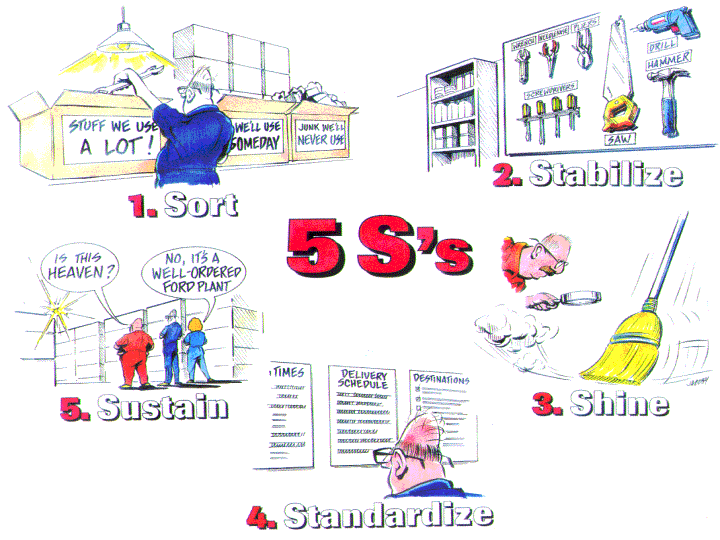
It is said that the average person spends 20 minutes a day or more looking for various belongings. Over the course of a lifetime (for example 70 years), that can add up to over 8,517 hours – almost an entire year spent searching!
You’ll have heard the maxim “A place for everything and everything in it’s place”. Well, the Japanese have taken that one step further and have developed a system for use in their factories called “5S”.
Translated into English, the five phases are:
Sorting
Straightening (or Setting in Order, or Stabilize)
Sweeping (or Shining, or Systematic Cleaning)
Standardizing
Sustaining
Sorting
“Sorting” is the step for eliminating the “unnecessary”. Keep only what you think you will use in the next year or so and/or items that would be very expensive or difficult to replace (this will be dictated by your available space.) This is the stage that brings out the “hoarder” in us.
Drawings that your 3-year-old created for his mommy or daddy can be near impossible to part with. Get creative and take a high-resolution photo or scan of it. A digital file takes up no physical space (but don’t forget to have a backup of your hard drive in a safe place!)
Consider donating items that still have some use left in them to family members, friends, or to a charity. Other avenues would be to sell or give away the items on Craigslist, Kijiji, or one of the Freecycle email lists.
Straightening
“Straightening” is the step for finding a home for each item. Think of the first time that you saw a well-organized workshop… cabinets with the drawers labeled with their contents, the pegboard with a painted outline around each tool, the jars of specialized nails, bolts, and screws, etc. This is the ultimate expression of the “straightening” step.
Practically, it doesn’t make much sense to paint around the desired location of every item in your home. A better approach would be to find a commonality between different items and find a logical location to house those items.
For example, items such as keys, gloves, umbrellas, dog leashes, etc. should be kept near the most frequently used entrance to the home. How often have you heard the question, “Honey, do you know where I put my keys?”
Children can learn this concept from an early age by creating a system of organization for their toys. Small boxes can be purchased or cut down from cardboard boxes to fit under the children’s beds. You can create an activity for marking the different boxes with the type of toy that belongs to each. Playing time should always include a few minutes to gather the toys and put them in their “homes”, which brings us to the next step…
Sweeping
“Sweeping” is the step for cleaning and returning items to their rightful home. Keeping your home clean and tidy shouldn’t be an all-day (or longer) exercise. Once you develop the habits to return everything to its place, it will no longer be necessary to “catch up” with days or weeks of neglect.
As well, it will be easier to muster the energy to vacuum, dust, or polish when you don’t have to spend all your time moving clutter around.
Standardizing
“Standardizing” means that all members of the household know what is expected of them. Keeping a system like this in place will require the cooperation of everyone in the household. It’s not just the “act” of following the system but the “frequency” or schedule of duties that makes it work.
Children, of virtually any age, can be given scheduled tasks that suit their abilities. This takes some of the burden off of the parents and teaches valuable self-reliance and self-disciplinary skills that will pay dividends in their adult lives.
Sustaining
“Sustaining”, the most important step. What would be the point of all this positive change if you just end up falling back into your old habits? Especially in the first few months, set aside about 15 minutes a week to talk about what is and isn’t working about the present system.
Allow a free discourse about possible improvements, and if agreed to, incorporate those changes into the first 4 S’s.
To Summarize:
Realize that incorporating changes to your lifestyle, especially in such a structured way, will take time to implement. The future benefits in creating a more stress-free, spacious, and harmonious home far outweigh the drawbacks.
Quite honestly, who couldn’t use another 20 minutes a day of free time?